Flash UI Prototyping
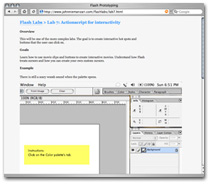
Flash has become an indispensable tool for UI prototyping. I created a series of labs in 2004 to help members of the user interface team at Adobe Systems learn the fundamentals of UI prototyping. These labs provide a digestible way to step through the key issues related to using Flash MX for UI prototypes. They're not particularly useful if you want to use Flash as strictly an animation tool. For example, they don't cover onion skinning. But if you want to learn how to construct interactive projects, it's a good starting point.
See the overview page or jump right in to the labs on tracking user behavior, interactivity and custom cursors.
Papers
A wise professor by the name of Barry Katz offered a course called History and Philosophy of Design that I took my third year at Stanford University. What may come as a surprise to those not in the engineering or design community is that university programs in those disciplines rarely require students to be educated in the historical context of the field. Ridiculous. I wrote this paper as a part of that class:
The Importance of Interactivity in Twenty-first Century Design: A Call for the Creation of the Interaction Designer (Download PDF File)
If you read this paper and it feels outdated or a bit sloppy, keep in mind it was written back in either 1999 or 2000 by a college undergraduate. If you find it problematic rest assured that someday I will offer a revised version... maybe when I go back for my graduate coursework. (I'll always keep the original version on my site because it's been linked to from a number of other sites from around the world.)
Books: Business
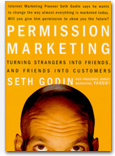
Permission Marketing: Turning Strangers Into Friends And Friends Into Customers
By Seth Godin
Jon Bruck pointed me to Seth Godin's books in early 2003 when I asked him for books he recommended to designers interested in business. It may seem out of place to have a series of books devoted to marketing on a website focused on design, but as Seth Godin points out in his book: marketing is the new design. Blowing $300 million on an ad campaign to build brand awareness or peddle a mediocre product is not going to work today like it did fifty years ago (Carly Fiorina, take a note). Seth Godin points to more effective, less expensive techniques for marketing a product. How can the tech industry learn from the airline industry's use of frequent flier miles? It's all about Permission Marketing.
Buy from Amazon and support this site
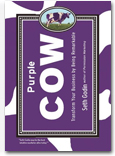
Purple Cow: Transform Your Business by Being Remarkable
By Seth Godin
Seth Godin wrote Purple Cow after Permission Marketing. The thesis of Purple Cow is easy to explain in just one sentence: "Creating products that are innovative is actually cheaper than advertising average products." So Godin says, "Stop advertising and start innovating." There's a reason Amazon stopped all TV advertisement and decided instead to put that money in to free shipping. The Tony the Tiger style brand building of previous decades doesn't work anymore. People are too bombarded with advertising to even notice. So stop running those full page ads in the newspaper and put that money in to product innovation. Take what you would have blown on the TV ad campaign and put it in to making your product remarkable, building a Purple Cow.
Buy from Amazon and support this site
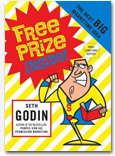
Free Prize Inside!: The Next Big Marketing Idea
By Seth Godin
Product innovation, creating a Purple Cow, doesn't necessarily need to result from a huge R&D budget. Not everyone has the time, money or expertise to build a Segway. Godin points to "soft innovation" like the free prize that comes inside a box of cereal. AOL found the free prize in offering free hours and easy installation; Prodigy was destroyed. But as you can see in the previous example, the free prize fades over time. Look at Krispy Kreme. Successful companies keep the innovations coming. They keep people engaged. At the end of the book Godin offers some tips for continuous innovation. He tosses aside brainstorming for another technique that gets people to find edges, or extremes, along different dimensions that define a product.
Buy from Amazon and support this site
Books: Graphic Design
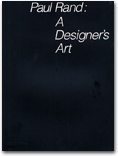
A Designer's Art
By Paul Rand
I'm of the opinion that an interaction designer can learn more by reading Paul Rand than any work by a member of the NN Group. Paul Rand began his career in media promotion and cover design, then moved to advertising design and corporate identification. He was also interested in design education, teaching at several schools, and serving as professor at Yale University from 1956 until 1993. He was a design consultant for major corporations including IBM, Cummins Engine Company, Westinghouse Electric Company and NeXT. Logos for IBM, Westinghouse, United Parcel Service (UPS) and ABC Television are canonical examples of his work. This book is one of Rand's later writings and at one point was out of print. There are used copies still in circulation and there may also be a new run available; I recommend picking one up.
Buy from Amazon and support this site
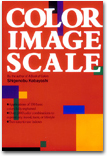
Color Image Scale
By Shigenobu Kobayashi
Japanese color psychologist Kobayashi sets up an easy to use and highly insightful look into over 1000 color combinations to express any mood, taste, or lifestyle. This book was recommended to me by Lynn Shade, an international interface designer at Adobe Systems. She recommended the book to me back in 1999. I was for fortunate to have the opportunity to travel to Japan with her in 2004. Japanese have a passion about color and materials that is hard to find in other places in the world. The book is eye-opening for both artists and non-artists alike, and is one of my favorite books.
Buy and Amazon and support this site

The Elements of Typographic Style
By Robert Bringhurst
Robert Bringhust is an American-born poet, book designer, and typographer. He acquired a B.A. from Indiana University in 1973 and an M.F.A. from the creative writing program at UBC in 1975, where he later taught. One of the most complete books on type and page layout, this books is a must for anyone interested in graphic design. Using a histrical perspective, Bringhurst describes in a very detailed way how one should go about designing the typographic layout of a project. He also provides background on type history, designers and distributers.
Buy and Amazon and support this site
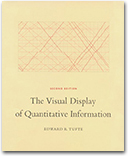
The Visual Display of Quantitative Information
By Edward Tufte
Edward Tufte earned his B.S. and M.S. degrees in statistics from Stanford University and his Ph.D. in political science from Yale in 1968. He has been a Professor of Political Science and Statistics at Yale University since. Tufte has consulted for CBS, NBC (two large American television networks), The New York Times, Newsweek, and the Department of Justice. Tufte helps reveals insights into information design and communication. This book demonstrates that design straddles a fine line between aesthetic gratification and goal-fulfilling function.
Buy and Amazon and support this site
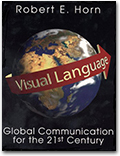
Visual Language
By Robert Horn
Robert Horn is a political scientist with a special interest in policy communication, social learning, and knowledge management. For the past 7 years, he has been a visiting scholar at Stanford University's Center for the Study of Language and Information (CSLI). I came across his work while I was working in the Persuasive Technology Lab which was also part of the CSLI. Horn sets up a grammar for communicating by combining words and images. As the population that designers have to deal with grows more international, it is important to learn how to communicate using the most global language possible. To be frank, the work that is in Horn's books are quite ugly. Compared to Tufte his examples lack a finesse and sensitivity to form, color, proportion, harmony. That said, if you can bring that sensitivity to his ideas, you'll be all that much better off. Don't discount the ideas because of his particular execution.
Buy from Amazon and support this site
Books: Designing Technology
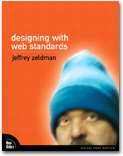
Designing with Web Standards
By Jeffrey Zeldman
Jeffrey Zeldman runs Happy Cog Studios, publishes A List Apart For People Who Make Websites, and writes books and articles to save us from making mistakes we'll regret later. If you are building a website, get this book immediately. Read it first thing tomorrow. If you care about Section 508 (accessibility) and/or not having front end code that is not an embarrassment (see google.com), you need to get on this. Jeff explains how you can take advantage of all the benefits of the latest standards like XHTML + CSS + W3C DOM and actually _improve_ the experience for poor grandma on Netscape 1.0 w/ a screen reader or your Linux nerd friend on Lynx.
Buy from Amazon and support this site
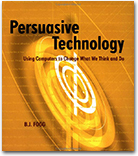
Persuasive Technology
By BJ Fogg
BJ Fogg directs research and design at the Stanford Persuasive Technology Lab at Stanford's Center for the Study of Language and Information and affiliated with Media-X. I was involved with this lab while I was in school, and it looks at interactive technologies designed to change people's attitudes and behaviors. BJ leads projects on online credibility, mobile persuasion, and operant conditioning via computing systems. The premise is that objects evoke a response. Serious design, by definition, evokes a strong response. This book is about designing for experiences beyond the aesthetic and experiential. It is about design that is focused on changing an individual: to improve a life... or to improve profits. I recommend this book to designers and non-designers alike.
Buy from Amazon and support this site
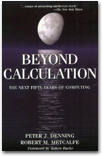
Beyond Calculation
Edited by Peter Denning and Robert Metcalfe
Peter Denning is a professor of Computer Science and worked on projects for NASA at the Ames Research Center. Robert Metcalf, the inventor of the Ethernet, proposed "the value of a network can be measured by the square of its number of users. More simply: Connected computers are better. Having the only telephone in the world would be of zero value, but this value increases for each new telephone it can call." This book contains essays about the next 50 years of computing. Authors include some of the most prominent writers in the human-computer interaction field: Mark Weiser, Sherry Turkle, Don Norman, Terry Winograd and others. The essays are less of a science fiction approach to forecasting the future, and more of a design manifesto that describes what aspect of technology will be most influential.
Buy from Amazon and support this site
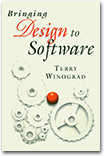
Bringing Design to Software
Edited by Terry Winograd
One of my fundamental beliefs is that inspiration and methods can be derived from user-oriented disciplines outside of computing as well. The first book I read that seriously looked at this issue was Terry Winograd’s Bringing Design to Software published in 1996. Winograd, professor of Computer Science at Stanford University, advocates the need for software to be designed, not just engineered. Articles are from some of the most influential minds in the field: Don Norman (Norman Neilson Group), Mitch Kapor (designer of Lotus 1-2-3), David Kelley (President of IDEO), and others.
Buy from Amazon and support this site
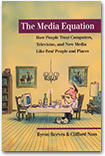
The Media Equation
By Clifford Nass and Byron Reeves
Nass and Reeves demonstrate, through research at Stanford University, that the same psychological rules that apply to human-human interaction also apply to human-computer interaction. Their research has been extremely influential and has changed affected interface design at Microsoft and HP. Although Cliff Nass and I both feel at this time that agents only make sense in very specific circumstances in the design of software applications, the bulk of their research remains applicable and extremely helpful to user interface designers regardless of whether they choose to use agents or not, especially if they have to interact with social scientists in the course of their day. I find most of their research to be most helpful when I have to justify design choices that I made based on intuition to other members of design and engineering teams.
Buy from Amazon and support this site
Books: Psychology

Influence: The Psychology of Persuasion
By Robert Cialdini
Cialdini uses an anecdotal method to teach very applicable social psychological theories of persuasion. These theories translate to the design of software, as Nass and Reeves demonstrate in the Media Equation.
Books in the Queue
Built to Last
John Maeda's new book Creative Code
I also need to add John Maeda's old book to this page.

